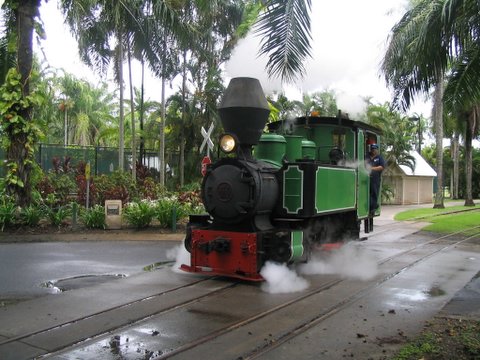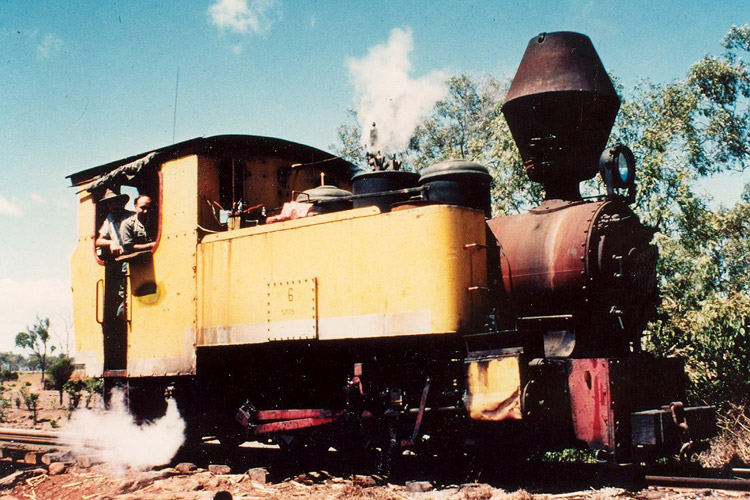|
|
Millaquin Mill No.6 / Qunaba Mill No.5 ‘Dobbin’ / ‘Speedy’ Statically displayed at Port Douglas |
|

‘Speedy’ displayed at the former Port Douglas Marina
Station on 14 May 2022 as seen in this photo kindly contributed by Chris
Stratton.
I understand the former station now serves
as a café restaurant, providing visitors with an opportunity to inspect the
locos and rollingstock.
A run-around track that ran in the foreground has been lifted
& landscaped.
|
Bundaberg Foundry Engineers Ltd |
|
|
Builder’s Number & Year |
6 of 1952 |
|
Wheel Arrangement |
0-6-2T |
|
The Bundy Fowler locos The well-known manufacturer John Fowler &
Co, Leeds, UK built many steam locomotives for the Australian sugar cane
industry, where their products were held in high regard. In 1935, John Fowler
& Co made a strategic decision to cease manufacture of steam locomotives
in favour of internal combustion designs, leaving a market gap in the
Australian sugar industry where demand for steam locomotives remained.
Stepping in to fill this gap were Australian companies Perry Engineering in
Adelaide, and Bundaberg Foundry Engineers Ltd (Bundaberg Foundry) who
leveraged their established heavy engineering business serving the cane mills
of Queensland’s Burnett Region and beyond. By 1948, Bundaberg Foundry had obtained firm
orders from various mills for 8 steam locomotives based on recent John Fowler
& Co designs operating at Queensland mills, in particular 0-6-2T ‘Airdmillan’ (Fowler b/n 20763 of 1935), and with modernisations
such as roller-bearing axles. It seems a licence was eventually negotiated
with John Fowler & Co, but steel supply proved problematic in the
post-war years and the first loco was not completed until 1952. A single
0-4-2T version was among the 8 constructed. These antipodean Fowler cousins
became known as ‘Bundy Fowlers’ and were not only among the last steam
locomotives built in Australia, but also among the last in revenue service –
with all 8 Bundaberg-Fowler steam locomotives ultimately passing into
preservation. John Browning and Brian Webber have written a
comprehensive and well-illustrated account of the various steam and diesel
locomotives built and reconstructed by Bundaberg Foundry Engineers Limited in
‘Built by Bundaberg Foundry’ as referenced below. Rather than repeat the
information provided in that authorative work, I have sought here to provide
a brief background to the Bundy-Fowler steam locomotives and their
preservation careers. Millaquin Mill No.6 / Qunaba Mill No.5
‘Dobbin’ / ‘Speedy’ The sixth-built Bundy Fowler locomotive was
delivered in 1952 to Millaquin Mill, near Bundaberg, becoming No.6 on the
roster. Here it laboured hard during the harvest seasons, hauling heavy loads
of cut sugar cane from the fields to the mill for processing and returning to
the fields with long strings of empties for refilling. The loco was transferred to nearby Qunaba
Mill in 1978. Here it became No.5 and was named ‘Dobbin’ by driver Russell Francis. (Qunaba Mill’s intriguing name
is derived from Queensland National Bank, which owned the mill at one stage.) In 1981 the loco was purchased from Millaquin
Sugar Co. to work the Bally Hooley Commuter at Mossman Mill, in Queensland’s
tropical far north. A large circular ‘Balley Hooley’ nameplate was attached
to locos cabside, with initial tourist train operations in the 1980’s
starting from Mossman Mill and taking tourists out to the canefields. In 1987
tourist operations were extended to Port Douglas, which had become the focus of
resort and golf club developments being built along either side of the
railway. At some stage the Balley Hooley nameplates were removed and the loco
instead received the name 'Speedy'. At a later stage the Balley Hooley
operation became centred on a truncated 4km route from St Crispins through
the surrounding resorts to Port Douglas Marina, with modern stations provided
along the route, and locomotive turntables at each terminus. ‘Speedy’ was
joined by sister ‘Bundy’ (Bundy Fowler B/No.2 of 1952) and
the two provided a popular tourist service, finally also joined in 2017 by
No.4 ‘Nelson’ (Fowler 20273 of 1934). ‘Light Railways’ magazine of December 2021
carried the sad news that the Balley Hooley Steam Railway had come to an end
earlier that year. It was reported that rails were to be sold for re-use on
local sugar cane tramways, while the locomotives and carriages were to be
placed on display at the Port Douglas station as part of a café restaurant
development. Local news items reported that the owner understandably wished
to retire after 20 years dedicated to running the Balley Hooley Steam
Railway, and unfortunately a new owner to take over the railway as a going
concern had not been found – I suspect the COVID downturn would not have
helped in this regard. The former Balley Hooley Steam Railway locos
and rolling stock are now plinthed at the former Marina Station, which functions
as a restaurant / café with the railway equipment available for inspection. I
fear the tropical climate at Port Douglas will demand ongoing maintenance of
the locos and rollingstock. Included on the page for sister ‘Bundy’ (Bundy Fowler B/No.2
of 1952) are
photos of the remaining Balley Hooley railway infrastructure following the
recent lifting of track, which was once the important line connecting Port
Douglas with Mossman Mill. |

A closer view of Millaquin Mill No.6 displayed at the
former Balley Hooley Railway station at Port Douglas.
Prominent on the cabside is a large
‘Balley Hooley’ nameplate, and a discreet weather cap has been fitted over the
chimney.
This photo was kindly contributed by
Chris Stratton following his visit to Port Douglas on 14 May 2022.
Comparison with the 1977 view at Millaquin Mill (below)
suggests the side tanks have been renewed, as the inspection plate is no longer
evident.

Happier days as ‘Speedy’ steams at Port Douglas on 2
January 2005.
This view was kindly provided by Matt Fenn.

‘Speedy’ double-heading with sister ‘Bundy’ at Port Douglas
on 19 February 2005.
This view was kindly provided by Matt Fenn.

A visit to Mossman in 1981 found Bundaberg Fowler B/No.6
resting at Mossman Mill.
Prominent on the cabside is the large
brass ‘Balley Hooley’ nameplate attached for the Balley Hooley Commuter tourist
service.
The ‘BFC’ roundel on the smokebox door has been nicely
highlighted in this paint scheme.

Ross Driver kindly contributed this view of Millaquin Mill
No.6 in steam on the Millaquin Mill network in 1977.
References
|
a |
Light
Railway Research Society of Australia Inc. Web site (Retrieved
3 November 2018): 'Preserved
Australian Sugar Cane Locomotives' list by John Browning |
|
b |
Website for Bundaberg Walkers
Engineering Ltd, retrieved
12 September 2022 |
|
c |
Browning J.
& Webber B. ‘Built
by Bundaberg Foundry’, published 2012 by the Australian
Narrow Gauge Railway Museum Society, Woodford QLD ISBN
978-0-9596009-4-0 |
|
d |
'Light Railways - Australia's Magazine of Industrial &
Narrow Gauge Railways', Number 282,
December 2021, published by Light Railway Research Society of Australia
Inc. |
|
|
|
Page updated: 11 December 2022
|
Government Railways: |
|
|||||||||
|
Private & Industrial Railways: |
|